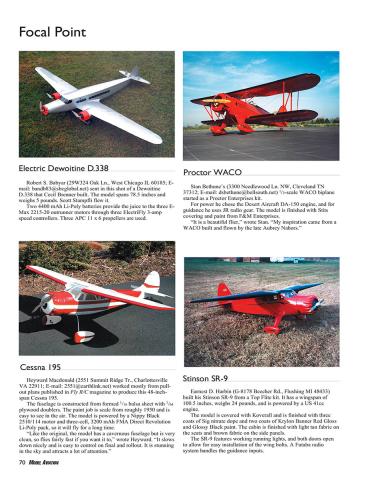70 MODEL AVIATION
Focal Point
Heyward Macdonald (2551 Summit Ridge Tr., Charlottesville
VA 22911; E-mail: [email protected]) worked mostly from pullout
plans published in Fly R/C magazine to produce this 48-inchspan
Cessna 195.
The fuselage is constructed from formed 1/16 balsa sheet with 1/64
plywood doublers. The paint job is scale from roughly 1950 and is
easy to see in the air. The model is powered by a Nippy Black
2510/114 motor and three-cell, 3200 mAh FMA Direct Revolution
Li-Poly pack, so it will fly for a long time.
“Like the original, the model has a cavernous fuselage but is very
clean, so flies fairly fast if you want it to,” wrote Heyward. “It slows
down nicely and is easy to control on final and rollout. It is stunning
in the sky and attracts a lot of attention.”
Robert S. Babyar (29W324 Oak Ln., West Chicago IL 60185; Email:
[email protected]) sent in this shot of a Dewoitine
D.338 that Cecil Brenner built. The model spans 78.5 inches and
weighs 5 pounds. Scott Stampfli flew it.
Two 4400 mAh Li-Poly batteries provide the juice to the three EMax
2215-20 outrunner motors through three ElectriFly 3-amp
speed controllers. Three APC 11 x 6 propellers are used.
Earnest D. Harbin (G-8178 Beecher Rd., Flushing MI 48433)
built his Stinson SR-9 from a Top Flite kit. It has a wingspan of
100.5 inches, weighs 24 pounds, and is powered by a US 41cc
engine.
The model is covered with Koverall and is finished with three
coats of Sig nitrate dope and two coats of Krylon Banner Red Gloss
and Glossy Black paint. The cabin is finished with light tan fabric on
the seats and brown fabric on the side panels.
The SR-9 features working running lights, and both doors open
to allow for easy installation of the wing bolts. A Futaba radio
system handles the guidance inputs.
Stinson SR-9
Electric Dewoitine D.338
Cessna 195
Stan Bethune’s (3300 Needlewood Ln. NW, Cleveland TN
37312; E-mail: [email protected]) 1/3-scale WACO biplane
started as a Proctor Enterprises kit.
For power he chose the Desert Aircraft DA-150 engine, and for
guidance he uses JR radio gear. The model is finished with Stits
covering and paint from F&M Enterprises.
“It is a beautiful flier,” wrote Stan. “My inspiration came from a
WACO built and flown by the late Aubrey Nabors.”
Proctor WACO
07sig3.QXD 5/23/07 10:21 AM Page 70
July 2007 71
Bill Peel (3523 Grossi Cir. NE, Canton OH 44714; E-mail:
[email protected]) was tired of seeing the same, old blue-and-yellow
PT-19s modeled, so he kit-bashed a Dynaflite PT-19 kit and
modified it to be a PT-26.
It spans 89 inches and weighs 17 pounds. A Saito 1.80 fourstroke
engine is used for power, and a JR 9303 radio is installed.
Bill covered his PT-26 with 21st Century Fabric, and Krylon
paints and custom markings were applied. A top coat of Minwax
polyurethane clear semigloss was applied to seal and protect the
paint and markings. The model features Robart struts and wheels.
Kit-Bashed PT-26
Marty Meyer (160 Locust Ave., New Rochelle NY 10805) built
his Ultimate Fun Fly design from a Sig Manufacturing kit.
He covered the profile fuselage with fiberglass cloth and epoxy
resin and finished it with two coats of primer, four coats of DuPont
acrylic lacquer, and three coats of polyurethane clear. He covered
the wings and the tail feathers with UltraCote.
A Rossi .45 engine easily pulls the 6-pound model through its
paces. It has a 42-inch wingspan and utilizes a Futaba T6XA radio
system.
Keith Masson (410 Wheeler Rd., Ashby MA 01431; E-mail:
[email protected]) built and modified his Shrike 10 from a
Lanier kit. He added stabilizers to either side of the wide body to
achieve a look that is reminiscent of an F-15 Eagle.
The model sports Futaba radio gear, and three channels are used.
An O.S. .15 LA engine provides more than enough power.
“This little airplane is very fast and agile at high speeds, but with
the addition of the stabilizers it becomes an almost tame and smooth
flier at low speeds, and it has an extended glide distance without
power,” wrote Keith. “To sum up, this model is simply fast, fun, and
impressive!”
Modified Shrike
Ultimate Fun Fly
Doug Claypool (102 Markleham Pl., Louisville KY 40245; Email:
[email protected]) constructed his 1/4-scale de
Havilland D.H.94 Moth Minor from Jerry Bates plans. It is powered
by a Saito 1.25 four-stroke engine and weighs 15.5 pounds.
Doug covered his model with Solartex. He obtained the landing
gear from Century Jet Models. A Futaba 6EX 2.4 GHz system is
used for guidance. According to Doug, the Moth Minor is graceful
and realistic in the air.
Moth Minor
See page 215 for submission guidelines
Focal Point
07sig3.QXD 5/23/07 10:21 AM Page 71




